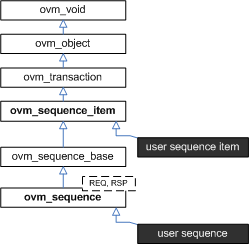Sequence Classes
Sequences encapsulate user-defined procedures that generate multiple ovm_sequence_item-based transactions. Such sequences can be reused, extended, randomized, and combined sequentially and hierarchically in interesting ways to produce realistic stimulus to your DUT.
With ovm_sequence objects, users can encapsulate DUT initializaton code, bus-based stress tests, network protocol stacks-- anything procedural-- then have them all execute in specific or random order to more quickly reach corner cases and coverage goals.
The OVM sequence item and sequence class hierarchy is shown below.

- ovm_sequence_item - The ovm_sequence_item is the base class for user-defined transactions that leverage the stimulus generation and control capabilities of the sequence-sequencer mechanism.
- ovm_sequence #(REQ,RSP) - The ovm_sequence extends ovm_sequence_item to add the ability to generate streams of ovm_sequence_items, either directly or by recursively execting other ovm_sequences.